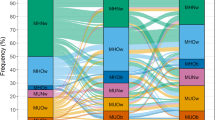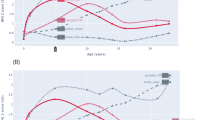Abstract
Objective:
The possibility that a subset of persons who are obese may be metabolically healthy—referred to as the ‘metabolically healthy obese’ (MHO) phenotype—has attracted attention recently. However, few studies have followed individuals with MHO or other obesity phenotypes over time to assess change in their metabolic profiles. The aim of the present study was to examine transitions over a 6-year period among different states defined simultaneously by body mass index (BMI) and the presence/absence of the metabolic syndrome (MetS).
Methods:
We used repeated measurements available for a subcohort of participants enrolled in the Women’s Health Initiative (N=3512) and followed for an average of 6 years to examine the frequency of different metabolic obesity phenotypes at baseline, the 6-year transition probabilities to other states and predictors of the risk of different transitions. Six phenotypes were defined by cross-tabulating BMI (18.5–<25.0, 25.0–<30.0, ⩾30.0 kg m−2) by MetS (yes, no). A continuous-time Markov model was used to estimate 6-year transition probabilities from one state to another.
Results:
Over the 6 years of follow-up, one-third of women with the healthy obese phenotype transitioned to the metabolically unhealthy obese (MUO) phenotype. Overall, there was a marked tendency toward increased metabolic deterioration with increasing BMI and toward metabolic improvement with lower BMI. Among MHO women, the 6-year probability of becoming MUO was 34%, whereas among unhealthy normal-weight women, the probability of ‘regressing’ to the metabolically healthy normal-weight phenotype was 52%.
Conclusions:
The present study demonstrated substantial change in metabolic obesity phenotypes over a 6-year period. There was a marked tendency toward metabolic deterioration with greater BMI and toward metabolic improvement with lower BMI.
This is a preview of subscription content, access via your institution
Access options
Subscribe to this journal
Receive 12 print issues and online access
$259.00 per year
only $21.58 per issue
Buy this article
- Purchase on Springer Link
- Instant access to full article PDF
Prices may be subject to local taxes which are calculated during checkout



Similar content being viewed by others
References
Flegal KM, Carroll MD, Kit BK, Ogden CL . Prevalence of obesity and trends in the distribution of body mass index among US adults, 1999-2010. JAMA 2012; 307: 491–497.
Ford ES, Giles WH, Dietz WH . Prevalence of the metabolic syndrome among US adults: findings from the Third National Health and Nutrition Examination Survey. JAMA 2002; 287: 356–359.
Meigs JB . Epidemiology of the insulin resistance syndrome. Curr Diab Rep 2003; 3: 73–79.
Sathyaprakash R, Henry RR . Preventing diabetes by treating aspects of the metabolic syndrome. Curr Diab Rep 2002; 2: 416–422.
Alexander CM, Landsman PB, Teutsch SM, Haffner SM . NCEP defined metabolic syndrome, diabetes, and prevalence of coronary heart disease among NHANES III participants age 50 years and older. Diabetes 2003; 52: 1210–1214.
Bianchini F, Kaaks R, Vainio H . Overweight, obesity, and cancer risk. Lancet Oncol 2002; 3: 565–574.
Wildman RP . Healthy obesity. Curr Opin Nutr Metab Care 2009; 12: 438–443.
Reaven G . All obese individuals are not created equal: insulin resistance is the major determinant of cardiovascular disease in overweight/obese individuals. Diabetes Vasc Dis Res 2005; 2: 105–112.
Field AE, Camargo CA, Ogino S . The merits of subtyping obesity: one size does not fit all. JAMA 2013; 310: 2147–2148.
Karelis AD, St-Pierre DH, Conus F, Rabassa-Lhoret R, Poehlman ET . Metabolic and body composition factors in subgroups of obesity: what do we know? J Clin Endocrinol Metab 2004; 89: 2569–2575.
Pataky Z, Bobbioni-Harsch E, Golay A . Open questions about metabolically normal obesity. Int J Obesity 2010; 34: S18–S23.
Primeau V, Coderre L, Karelis AD, Brochu M, Lavoie ME, Messier V et al. Characterizing the profile of obese patients who are metabolically healthy. Int J Obesity 2011; 35: 971–981.
Den Engelsen C, Gorter KJ, Salomé PL, Rutten GE . Development of metabolic syndrome components in adults with a healthy obese phenotype: a 3-year follow-up. Obesity 2013; 21: 1025–1030.
Hwang YC, Hayashi T, Fujimoto WY, Kahn SE, Leonetti DL, McNeely MJ et al. Visceral fat accumulation predicts the conversion of metabolically healthy obese subjects to an unhealthy phenotype. Int J Obesity 2015; 39: 1365–1370.
Appleton SL, Seaborn CJ, Visvanathan R, Hill CL, Gill TK, Taylor AW et al. Diabetes and cardiovascular disease outcomes in the metabolically healthy obese phenotype. Diabetes Care 2013; 36: 2388–2394.
Bell JA, Hamer M, Sabia S, Singh-Manoux A, Batty GD, Kivimaki M . The natural course of healthy obesity over 20 years (letter). J Am Coll Cardiol 2015; 65: 101–109.
Eshtiaghi R, Keihani S, Hosseinpnah F, Barzin M, Azizi F . Natural course of metabolically healthy abdominal obese adults after 10 years of follow-up: the Tehran Lipid and Glucose Study. Int J Obesity 2015; 39: 514–519.
Hamer M, Bell JA, Sabia S, Batty GD, Kivimäki M . Stability of metabolically healthy obesity over 8 years: the English Longitudinal Study of Aging. Eur J Endocrinol 2015; 173: 703–708.
Bell JA, Kivimaki M, Hamer M . Metabolically healthy obesity and risk of incident type 2 diabetes: a meta-analysis of prospective cohort studies. Obesity Rev 2014; 15: 504–515.
Lotta LA, Abbasi A, Sharp SJ, Sahlqvist A-S, Waterworth D, Brosnan JM et al. Definitions of metabolic health and risk of future type 2 diabetes in BMI categories: a systemic review and network meta-analysis. Diabetes Care 2015; 38: 2177–2187.
Fan J, Song Y, Chen Y, Hui R, Zhang W . Combined effect of obesity and cardio-metabolic abnormality on the risk of cardiovascular disease: a meta-analysis of prospective cohort studies. Int J Cardiol 2013; 168: 4761–4768.
Kramer CK, Zinman B, Retnakaran R . Are metabolically healthy overweight and obesity benign conditions: a systematic review and meta-analysis. Ann Int Med 2013; 159: 758–769.
Rey-Lopez JP, de Rezende LF, de Sá TH, Stamatakis E . Is the metabolically healthy obesity phenotype an irrelevant artifact for public health? Am J Epidemiol 2015; 182: 737–741.
Bradshaw PT, Stevens J . Invited commentary: limitations and usefulness of the metabolically healthy obesity phenotype. Am J Epidemiol 2015; 182: 742–744.
Ray-Lopez, de Rezende LF, de Sá TH, Stamatakis E, Ray-Lopez et al. Respond to ‘the metabolically healthy obesity phenotype.’. Am J Epidemiol 2015; 182: 745–746.
Ruderman N, Chisholm D, Pi-Sunyer X, Schneider S . The metabolically obese, normal-weight individual revisited. Diabetes 1998; 47: 699–713.
Meigs JB, Wilson WF, Fox CS, Vasan RS, Nathan DM, Sullivan LM et al. Body mass index, metabolic syndrome, and risk of type 2 diabetes or cardiovascular disease. J Clin Endocrinol Metab 2006; 91: 2906–2912.
St Pierre AC, Cantin B, Mauriège P, Bergeron J, Dagenais GR, Després JP et al. Insulin resistance syndrome, body mass index and the risk of ischemic heart disease. CMAJ 2005; 172: 1301–1305.
Song Y, Manson JE, Meigs JB, Ridker PM, Buring JE, Liu S . Comparison of usefulness of body mass index versus metabolic risk factors in predicting 10-year risk of cardiovascular events in women. Am J Cardiol 2007; 100: 1654–1658.
Kuk JL, Arfern CI . Are metabolically normal but obese individuals at lower risk for all-cause mortality? Diabetes Care 2009; 32: 2297–2299.
Anderson GL, Manson J, Wallace R, Lund B, Hall D, Davis S et al. Implementation of the Women’s Health Initiative study design. Ann Epidemiol 2003; 13: S5–S17.
Langer RD, White E, Lewis CE, Kotchen JM, Hendrix SL, Trevisan M . The Women’s Health Initiative Observational Study: baseline characteristics of participants and reliability of baseline measures. Ann Epidemiol 2003; 13 (9 Suppl): S107–S121.
Howard BV, Adams-Campbell L, Allen C, Black H, Passaro M, Rodabough RJ et al. Int J Obes Relat Metab Disord 2004; 28: 1039–1047.
McTiernan A, Kooperberg C, White E, Wilcox S, Coates R, Adams-Campbell LL et al. Recreational physical activity and the risk of breast cancer in postmenopausal women: the Women’s Health Initiative Cohort Study. JAMA 2003; 290: 1331–1336.
Bergmeyer HU, Bernt E, Schmidt F, Stork H . Determination of hexiokinase and glucose-6-phosphate dehydrogenase. In: Bergmeyer HU (eds). Methods of Enzymatic Analysis. 2nd edn. Academic Press: New York, NY, USA, 1974, pp 1196.
Peterson JI, Young DS . Evaluation of the hexokinase-glucose-6-phosphate dehydrogenase method of determination of glucose in urine. Anal Biochem 1968; 23: 301–316.
Tietz NW . Fundamentals of Clinical Chemistry, 3rd edn. WB Saunders Co: Philadelphia, PA, USA, 1987; p 544.
Steiner P, Freidel J, Bremmer W, Stein E . Standardization of micromethods for plasma cholesterol, triglyceride and HDL-cholesterol with the lipid clinics’ methodology. J Clin Chem Clin Biochem 1981; 19: 850–851.
National Heart, Lung, and Blood Institute. Detection, evaluation, and treatment of high blood cholesterol in adults (Adult Treatment Panel III), final report. NIH Publication No. 02–5215, September 2002.
Grundy SM, Cleeman JI, Daniels ST, Donato KA, Eckel RH, Franklin BA et al. Diagnosis and management of the metabolic syndrome: an American Heart Association/National Heart, Lung, and Blood Institute Scientific Statement. Circulation 2005; 112: 2735–2752.
WHO Expert Consultation. Appropriate body-mass index for Asian populations and its implications for policy and intervention strategies. Lancet 2004; 363: 157–163.
Kuo HS, Chang HJ, Chou P, Teng L, Chen THH A . Markov chain model to assess the efficacy of screening for non-insulin dependent diabetes mellitus (NIDDM). Int J Epidemiol 1999; 28: 233–240.
Hinnouho G-M, Czernichow S, Dugravot, Nabi H, Brunner EJ, Kivimaki M et al. Metabolically healthy obesity and risk of mortality. Diabetes Care 2013; 36: 2294–2300.
Thomsen M, Nordesgaard BC . Myocardial infarction and ischemic heart disease in overweight and obesity with and without the metabolic syndrome. JAMA 2013; 174: 15–22.
Kip KE, Marroquin OC, Kelley DE, Johnson D, Kelsey SF, Shaw LJ et al. Clinical importance of obesity versus the metabolic syndrome in cardiovascular risk in women: a report from the Women’s Ischemia Syndrome Evaluation (WISE) study. Circulation 2004; 109: 706–713.
Berrahmoune H, Herbeth B, Samara A, Marteau J-B, Visvikis-Siest S . Five-year alterations in BMI are associated with clustering of changes in cardiovascular risk factors in a gender-dependent way: the Stanislas study. Int J Obesity 2008; 32: 1279–1288.
Rutter MK, Sullivan LM, Fox CS, Wilson PWF, Nathan DM, Vasan RS et al. Baseline levels, and changes over time in body mass index and fasting insulin, and their relationship to change in metabolic trait clustering. Metab Syndr Relat Disord 2014; 12: 372–380.
Bradshaw PT, Monda KL, Stevens J . Metabolic syndrome in healthy obese, overweight, and normal weight individuals: the Atherosclerosis Risk in Communities Study. Obesity 2013; 21: 203–209.
Acknowledgements
This work was supported by institutional funds from the Albert Einstein College of Medicine.
Author information
Authors and Affiliations
Corresponding author
Ethics declarations
Competing interests
The authors declare no conflict of interest.
Additional information
Supplementary Information accompanies this paper on International Journal of Obesity website
Supplementary information
Rights and permissions
About this article
Cite this article
Kabat, G., Wu, WY., Bea, J. et al. Metabolic phenotypes of obesity: frequency, correlates and change over time in a cohort of postmenopausal women. Int J Obes 41, 170–177 (2017). https://doi.org/10.1038/ijo.2016.179
Received:
Revised:
Accepted:
Published:
Issue Date:
DOI: https://doi.org/10.1038/ijo.2016.179
This article is cited by
-
Conversions between metabolically unhealthy and healthy obesity from midlife to late-life
International Journal of Obesity (2024)
-
Metabolic phenotypes and risk of colorectal cancer: a systematic review and meta-analysis of cohort studies
BMC Cancer (2022)
-
Association between non-alcoholic fatty liver disease and metabolically healthy deterioration across different body shape phenotypes at baseline and change patterns
Scientific Reports (2022)
-
Metabolically healthy obesity and physical fitness in military males in the CHIEF study
Scientific Reports (2021)
-
Metabolic health in normal-weight and obese individuals
Diabetologia (2019)



